Computer vision:
Computer vision is a field of artificial intelligence that focuses on enabling machines to understand, interpret, and analyze images and videos in a way similar to human vision.
This field combines techniques from machine learning, image processing, pattern recognition, and artificial vision to solve various problems related to visual analysis.
Image interpretation refers to the process of analyzing and understanding the content of an image. It involves extracting meaningful information, identifying objects, recognizing patterns, and making sense of the visual data presented in the image.
what is image interpretation?
In image interpretation, various techniques are used to analyze different aspects of the image, such as:
- Feature extraction: Identifying key features or characteristics in the image, such as edges, textures, colors, shapes, or objects.
- Object detection: Locating and identifying specific objects or regions of interest within the image, such as vehicles, people, buildings, or animals.
- Classification: Categorizing the objects or regions detected in the image into predefined classes or categories, based on their visual attributes.
- Semantic segmentation: Partitioning the image into meaningful segments or regions and assigning semantic labels to each segment to represent different objects or parts of the scene.
- Contextual analysis: Considering the surrounding context and relationships between objects in the image to improve understanding and interpretation.
Image interpretation is a fundamental task in fields such as computer vision, remote sensing, medical imaging, and geographic information systems (GIS). It enables applications ranging from autonomous driving and surveillance to medical diagnosis and environmental monitoring.
why Computer vision is important?
Computer vision is important for several reasons:
- Automation:Computer vision enables automation of tasks that traditionally require human vision, such as inspection, quality control, and sorting in manufacturing processes. This leads to increased efficiency, reduced costs, and higher productivity.
- Enhanced understanding:By analyzing and interpreting visual data, computer vision systems can provide insights and understanding of complex scenes, objects, and patterns, which can aid decision-making processes in various domains.
- Safety and security: Computer vision technologies, such as facial recognition and object detection, play a crucial role in enhancing safety and security by enabling surveillance systems, biometric identification, and threat detection in public spaces, airports, and critical infrastructure.
- Medical diagnosis: In the field of healthcare, computer vision contributes to medical imaging analysis, disease diagnosis, and treatment planning. It helps doctors and healthcare professionals to detect abnormalities in medical images, track disease progression, and provide more accurate diagnoses and treatments.
- Autonomous systems:Computer vision is a key component of autonomous systems, including self-driving cars, drones, and robots. By perceiving and understanding their environment through visual data, these systems can navigate, interact with, and adapt to dynamic surroundings without human intervention.
- Accessibility: Computer vision technologies can improve accessibility for people with disabilities by providing assistive devices and applications that interpret visual information and convert it into alternative formats, such as text or audio descriptions.
Overall, computer vision has a wide range of applications across various industries, including manufacturing, healthcare, transportation, agriculture, entertainment, and security, making it an essential and impactful field of study and development.
what are the applications of computer vision?
Computer vision has numerous applications across various industries. Some of the key applications include:
- Autonomous Vehicles: Computer vision enables self-driving cars to perceive and understand their surroundings, identify obstacles, recognize traffic signs and signals, and navigate safely on roads
- Surveillance and Security: Computer vision is used in surveillance systems for monitoring public spaces, airports, borders, and critical infrastructure. It includes tasks such as object detection, tracking, and anomaly detection to enhance security and safety
- Medical Imaging: Computer vision aids in medical imaging analysis for diagnosis, treatment planning, and surgical guidance. It helps detect abnormalities in medical images such as X-rays, MRIs, CT scans, and ultrasounds, improving healthcare outcomes
- Retail and E-commerce: Computer vision is employed in retail for inventory management, product recognition, shelf monitoring, and cashier-less checkout systems. It enhances the shopping experience and optimizes operations for retailers and e-commerce platforms
- Augmented Reality (AR) and Virtual Reality (VR):Computer vision powers AR and VR applications by overlaying digital information or virtual objects onto the real world. It enables immersive experiences in gaming, education, training, and visualization.
- Industrial Automation:Computer vision automates tasks in manufacturing and industrial processes, such as quality inspection, defect detection, robotic assembly, and inventory management, leading to increased efficiency and reduced costs.
- Agriculture:Computer vision helps farmers monitor crop health, detect pests and diseases, assess soil conditions, and optimize irrigation and harvesting processes. It enhances agricultural productivity and sustainability
التسميات
computer

